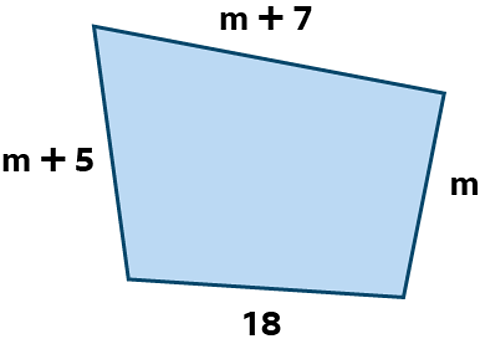Solving equations
For an equation, the expression on the left hand side is equal to the expression on the right hand side. This means the equation is balanced.
Balance method
We need to find a value for \(a\) which keeps this balance.
We could try different values until we hit on the correct value to balance the equation, but it is much better to have a method.
To solve a linear equation such as \(3a + 8 = 26\)
- Change the equation, keeping it balanced, so that all the unknown terms are on one side and all the numbers are on the other side
- Divide or multiply to find the value of the unknown
Check the answer by using your value in the original equation - it should be balanced. It's good to check!
To solve \(3a + 8 = 26\)
- Subtract 8 from each side of the equation. (Subtracting the same value from each side keeps the equation balanced.)
\(3a + 8 - 8 = 26 - 8\)
which gives \(3a = 18\)
This leaves just \(3a\) on the left hand side.
- Find the value of \(a\) by dividing by 3 remember that \(3a\) means \(3 \times a\)
\(a = 18 \div 3\)
\(a = 6\)
Check the answer
Look at the original equation \(3a + 8 = 26\)
Find the value of \(3a + 8\) when \(a = 6\)
This should be 26
When \(a = 6\)
\(3a = 3 \times 6\)
\(= 18\)
\(3a + 8 = 18 + 8\)
\(= 26\)
Both sides are equal to \(26\), so the answer is correct.

When an equation is solved, an answer can be:
- a whole number
- a decimal / fraction
- positive or negative
- greater than or less than 1
- equal to zero
Worked examples
Example
Solve the equation \(4c - 7 = 5\)
Solution
We want just \(4c\) on the left-hand side,
so add 7 to each side
\(4c - 7 +7 = 5 + 7\)
\(4c = 12\)
Divide by 4
\(c = 12 \div 4\)
\(c = 3\)
Check answer
Look at the original equation: \(4c - 7 = 5\)
When \(c = 3\)
\(4c = 4 \times 3\)
\(= 12\)
and \(4c - 7 = 12 = 7\)
\(= 5\)
Both sides are equal to \(5\), so the answer is correct
Test yourself
Solve the equation \(10y - 2 = 3\)
Add 2 to both sides
\(10y - 2 + 2 = 3 + 2\)
\(10y = 5\)
A common mistake at this point is to divide 10 by 5 and get an answer of 2. Always divide by the number in front of the unknown.
\(y = 5 \div 10\)
\(y = 0.5\)
Example
Solve the equation \(\frac{q}{3} + 11 = 18\)
Solution
We want just \(\frac{q}{3}\) on the left hand side,
so subtract 11 from each side.
\(\frac{q}{3} + 11 - 11 + 18 - 11\)
\(\frac{q}{3} = 7\)
Multiply by 3
\(q = 3 x 7\)
\(q = 21\)
Check answer
Look at the original equation\(\frac{q}{3} + 11 = 18\)
When \(q = 21\),
\(\frac{q}{3} = 21 \div 3\)
\(= 7\)
\(\frac{q}{3} + 11 = 7 + 11\)
\(= 18\)
Both sides are equal to 18 so the answer is correct.

Example
The diagram shows an isosceles triangle with the two equal sides, each \(d\) centimetres long.
The third side is 12cm long.
Given that the perimeter of the triangle is 27cm, form an equation to find the value of \(d\).

Solution
First set up an equation.
The perimeter is the distance right around the triangle, so add all the sides together.
\(Perimeter = d + d + 12\)
This simplifies to \(2d + 12\)
We were told that the perimeter is 27cm so we can write the equation:
\(2d + 12 = 27\)
To solve
subtract 12 from each side of the equation
\(2d + 12 - 12 = 27 - 12\)
which gives \( 2d = 15\)
Divide by 2 to find the value of \(d\)
\(d = 15 \div 2\)
\(= 7.5\)
Check answer
\(d\) = 7.5cm
Go back to the equation for the perimeter
\(2d + 12 = 27\)
When \(d\) = 7.5
\(2d = 2 \times 7.5\)
\(= 15\)
\(2d + 12 = 15 + 12\)
\(= 27\)
Both sides are equal to 27, so the answer is correct.

In this and similar questions, do not keep the cm in the equation!
It could get mixed up with the letters representing the unknown side.
The units are not an important part of the question and will often be already written on the answer line for you.
Test yourself
A quadrilateral has sides, measured in centimetres, as shown in the diagram below.
Given that the perimeter of the quadrilateral is 66cm, form an equation and hence find the length of the longest side.

Form an equation by adding the lengths of the 4 sides and putting the total equal to 66.
\(m + 5 + m + 7 + m + 18 = 66\)
Simplify the left hand side of the equation
\(m + 5 + m + 7 + m + 18 = 66\)
\(3m + 30 = 66\)
Solve the equation
\(3m + 30 - 30 = 66 - 30\)
\(3m = 36\)
\(m = 12\)
Once the equation has been solved, check what the question actually asked. There might be more working out to do!
Find which is the longest side
One of the sides is 18cm long
\(m + 7\) is longer than \(m\) or \(m + 5\)
We know that \(m = 12\), so the longest side is \(12 + 7 = 19\)
Answer 19cm
Example
Solve the equation \(3(5p - 2) - 4 = 35\)
Solution
In this example, the left hand side must be simplified before carrying out the steps to solve the equation.
First multiply out the bracket \(3(5p - 2) = 15p - 6\)
Put this into the equation \(15p - 6 - 4 = 35\)
Simplify the left hand side \(15p - 10 = 35\)
Solve the equation - add 10 to both sides
\(15p - 10 + 10 = 35 + 10\)
\(15p = 45\)
Divide by 15
\(p = 45 \div 15\)
\(p = 3\)
Check answer
Look at the original equation: \(3(5p - 2) - 4 = 35\)
When \(p = 3\),
\(3(5p - 2) - 4 = 3(15 - 2) - 4\)
\(= 3 \times 13 - 4\)
\(= 39 - 4\)
\(= 35\)
Both sides are equal to \(35\) so the answer is correct.

In the examples, detailed solutions have been shown to help with understanding. When doing these questions, there is no need to explain every stage or show every detail of the calculations.
Your answer for the last example could be as short as this:
\(3(5p - 2) - 4 =35\)
\(15p - 6 - 4 = 35\)
\(15p - 10 = 35\)
\(15p = 45\)
\(p = 3\)
Check:
\(3(15 - 2) - 4 = 39 - 4\)
\(= 35\)
Test yourself
More on M1: Algebra
Find out more by working through a topic